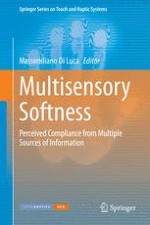2014 | OriginalPaper | Buchkapitel
5. Computational Aspects of Softness Perception
verfasst von : Massimiliano Di Luca, Marc O. Ernst
Erschienen in: Multisensory Softness
Verlag: Springer London
Aktivieren Sie unsere intelligente Suche, um passende Fachinhalte oder Patente zu finden.
Wählen Sie Textabschnitte aus um mit Künstlicher Intelligenz passenden Patente zu finden. powered by
Markieren Sie Textabschnitte, um KI-gestützt weitere passende Inhalte zu finden. powered by
